The higher-end CPUs these days need a crazy amount of cooling to keep things running cool and fast and the easiest way to do that has been to go with an All-In-One cooler. These are also the quickest way to integrate some lighting into your build as well with some of the AIO coolers having RGB fans and or RGB on their pumps. Enermax’s Aquafusion Adv lineup has both and is available in black or white and in 120, 240, and 360 configurations. This year we did upgrade our test bench from Z690 with the 12900K up to the Z790 with the 13900K, what better way than to start our cooler testing by testing out two of the Enermax Aquafusion Adv coolers as well as one of their air coolers, the ETS-F40-FS ARGB, so today I’m going to check out all three then put them all to the test to see how they perform with the always demanding 13900K.
Product Name: Catching Up with Enermax
Review Sample Provided by: Enermax
Written by: Wes Compton
Amazon Affiliate Links:
Enermax Aquafusion Adv 240 White
Enermax Aquafusion Adv 360 Black
|
Enermax ETS-F40-FS ARGB Specifications |
|
|
Color Options |
Black and White |
|
CPU Socket |
Intel® LGA 1700/1200/115x/2066/2011/2011-3/1366 AMD® AM5/AM4/AM3+/FM2+/FM1 |
|
Heatpipes |
4 |
|
Dimensions |
140 x 93 x 158 mm |
|
Fan Speed |
300 ~ 1200 RPM ±10% |
|
Fan Airflow |
18.11 ~ 74.33 CFM |
|
Fan Static Pressure |
0.13 ~ 2.17 mmH2O |
|
Noise Level |
10 ~ 23 dBA |
|
Connector |
4 Pin PWM + 3 Pin ARGB |
|
Warranty |
1 Year Warranty |
|
Enermax Aquafusion Adv Specifications |
|
|
Color Options |
Black White |
|
Radiator Size Options |
120 mm 240 mm 360 mm |
|
Radiator Dimensions |
120 - 154 x 120 x 27 mm 240 - 274 x 120 x 27 mm 360 - 394 x 120 x 27 mm |
|
CPU Socket |
Intel® LGA 2066/2011-3/2011/1700/1200/1366/1156/1155/1151/1150 AMD® AM5/AM4/AM3+/AM3/AM2+/AM2/FM2+/FM2/FM1 |
|
Fan Speed |
500 - 2000 RPM ±10% |
|
Fan Airflow |
39~79.8 CFM |
|
Fan Static Pressure |
0.67~3.6 mm-H2O |
|
Noise Level |
15~32.6 dBA |
|
Connector |
4 Pin PWM + 3 Pin ARGB |
|
Warranty |
5 Year Warranty |

Enermax ETS-F40-FS ARGB
To start things off I figured I would start small, relatively with the ETS-40-FS ARGB Version. Of course, this is only small when we compare it with the water coolers. The ETS-40-FS ARGB Version is one of a whole series of 140mm fan based air coolers from Enermax. This specific model has addressable RGB lighting for the fan and the top of the cooler as the name implies and they have it in both black and white models. But Enermax also has the ETS-40-FS and the ETS-40-FS Black as well. The packaging for the ETS-40-FS ARGB Version has two color options across the front, both with their lighting all lit up. They use a small sticker to let you know which version is inside the box. The Enermax brand name is up in the top left corner in red and the ETS-40-FS ARGB Version model name is below that, but the ARGB part is in a very small font. Then along the bottom, they let you know all of the different motherboard lighting software that is supported as well as a few icons showing the coolers features. They also show the CPU sockets supported which cover both Intel and AMDs CPUs for the past 10+ years. The side of the box has line drawings of the cooler so you know all of the dimensions and they have a full specification listing as well. I really wish more products had all of this information on the packaging. Then around on the back, they have a few more pictures that highlight the main features.




Inside, there is a layer of foam up on top and tucked in on both sides of the cooler. The fan is wrapped in a cardboard box and all of the accessories have their own box as well. You get a user manual which covers all of the different ETS-F40 models with installation instructions. You have a bag with four fan brackets meaning you have two extra if you want to install a push-pull configuration. Then the big bag has all of the installation components. There is a bottom bracket for intel installations as well as two smaller top brackets or a big single bracket for AMD installs. All of the hardware except for the new LGA 1700 studs are blacked out as well.



The ETS-F40 ARGB comes with one Enermax F40-ARGB 140MM PWM Fan which is the model number AFS40ARGB-14. This has a black housing and a translucent white fan blade which has 9 blades. It runs from 300 RPM up to 1200 RPM and pushes 74.33 CFM with a static pressure of 2.17 mmH2O. Enermax has it rated at up to 23 dBA for noise. This is a four-pin PWM fan and it has an additional 3-pin ARGB lighting header as well. That lighting cable does have a smaller plug in the middle of it for hooking up the lighting on the heatsink as well, you can see it right next to where the wiring goes into the fan. The lighting cable has both input and outputs so it can be daisy-chained as well. The fan has a black Enermax sticker in the middle and then the housing isn’t a standard square, you can see it bulges out in between the mounting holes which do have some rubber isolation. Then on the sides, they have the Enermax branding as well.





The ETS-F40-FS ARGB is 158 mm tall, 140mm wide, and 93mm deep. The entire heatsink has been finished in black including its four direct contact heatpipes. Those heatpipes run up both sides of the cooler and are machined down at the bottom to have direct contact with the CPU, with that you can see the copper finish there. Enermax has hidden the serial number sticker up under the cooler, I’m surprised they have one at all for an air cooler but I am glad it is hidden away at least. Then up on top, the ETS-F40-FS ARGB has a plastic cover across the entire top. This covers up the exits for the heatpipes and allowed them a little room for styling which weaves thicker black lines in and over the thinner white translucent ARGB backlit lines. Then in the center, the Enermax logo is printed on in silver. The heatsink shape has a V on the fan side in the center, this is where they run the small cable for the lighting and it is what they call the vortex generator flow design that is designed to move more air around the heatpipes. The ETS-F40-FS ARGB is rated at 200 watts of cooling power which isn’t bad for a 140mm air cooler that isn’t a huge double tower design.








Enermax Aquafusion Adv
The Enermax Aquafusion Adv is available in three different radiator sizes with all three using 120mm fans they have the single fan 120mm, dual fan 140mm, and triple fan 360mm models. Each is also available in white and black color options. To get a feel for the whole lineup they sent over the Aquafusion Adv 240 in white and the Aquafusion Adv 360 in black. Both have a similar packaging design which has a black background and the Aquafusion Adv branding along the bottom with a rainbow effect below that highlights the RGB lighting. The Enermax red logo is in the top left corner and the front of the box on both also have all of the different motherboard RGB software certifications. Of course, the longer 360 model has a larger box and they both have pictures that match their specific model across the front. I’m a huge fan of packaging having a picture of what you are getting so I was happy to see this, it makes shopping in a store a lot easier. The back of the boxes have a full specification listing which also helps as well and then six photos that help show some of the key features along with short descriptions below each.


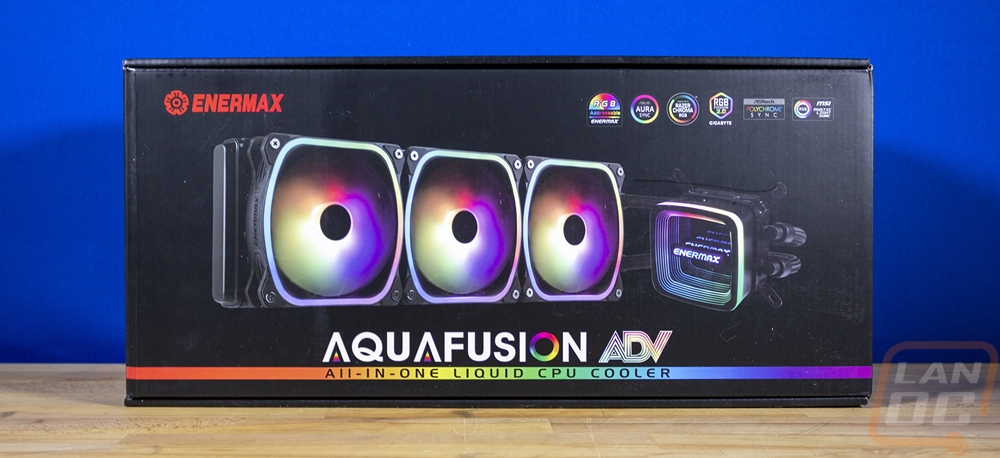
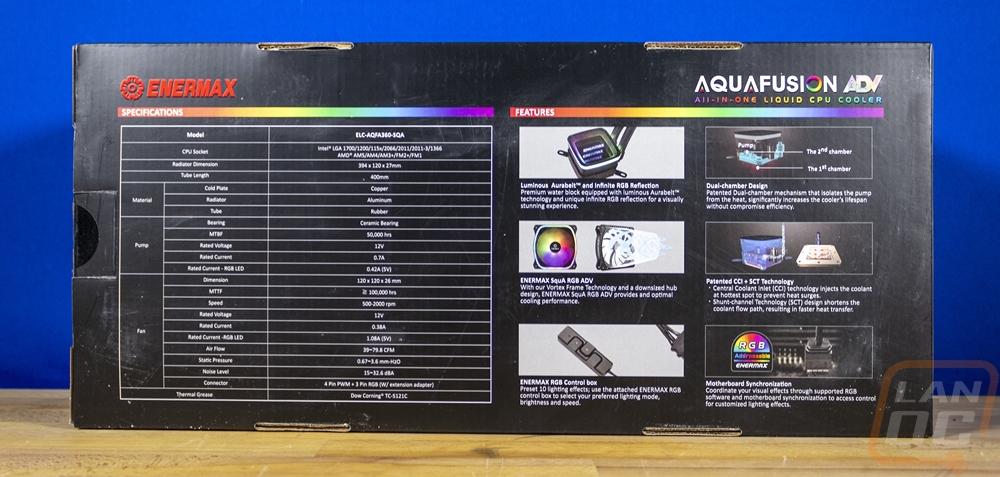
Once you open up the box you will find the user manual on top and a removable layer of foam. Then below that with both models, the coolers come in a formed cardboard tray. Each component is bagged up including each fan and the radiator also has a slide-on cardboard cover as well to give it additional protection from damage. You have a bag filled with cables and then a big bag with all of the mounting hardware. Both the 240 and 360 that we have here come with a small basic RGB controller along with the cables that help adapt it to a few of the different motherboard connections. You have a SATA power plug that plugs into the included controller and then a fan splitter which depending on the model slits to two or three fans. There is also a cable that plugs into the pump for its RGB lighting controls. You get a back bracket for Intel but not AMD, they use the stock AMD backplate and you have two sets of pump brackets depending on if you are going AMD or Intel. On both the white and black models, all of this hardware is black. You get a small tube of thermal paste and then six small bags of mounting hardware. The AMD hardware is market and only one bag, the one with the small bracket mounting screws is a reusable bag the rest tear open.




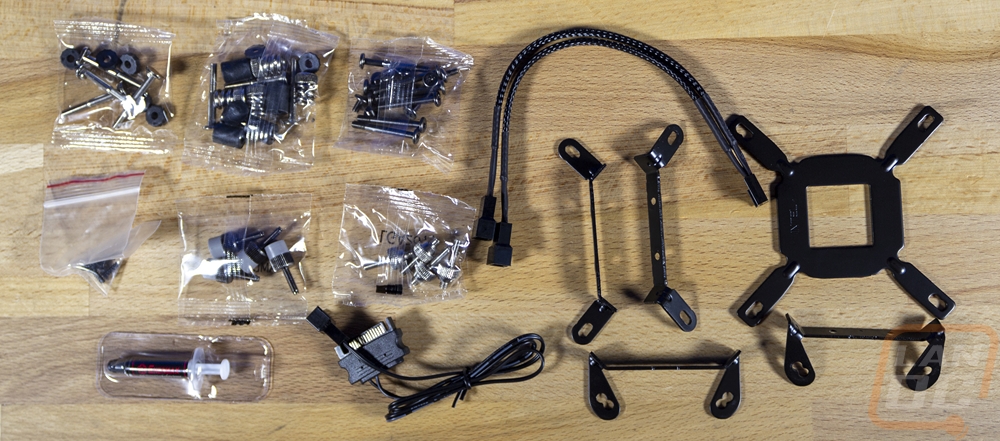

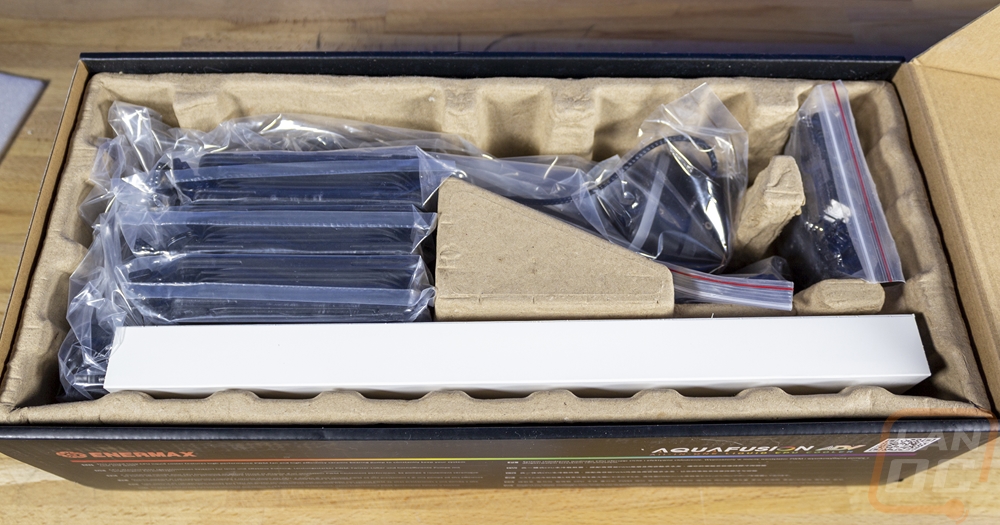
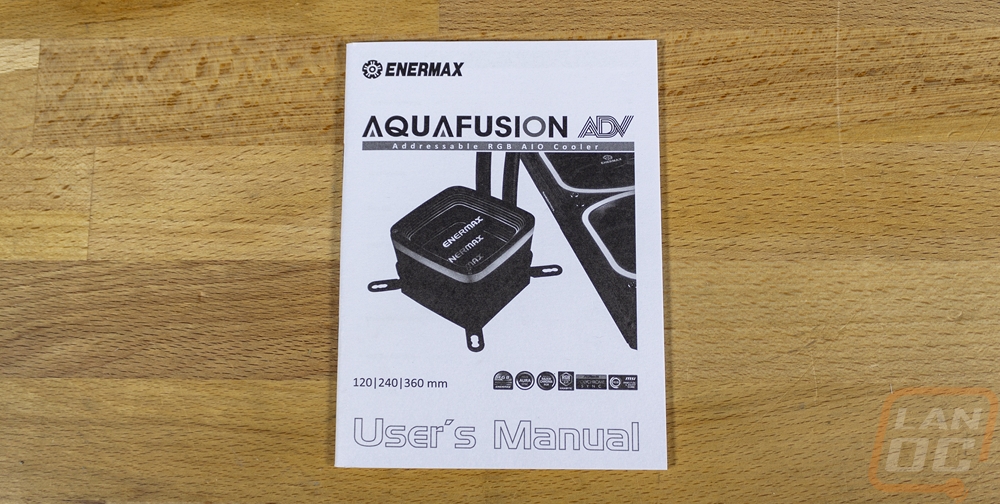


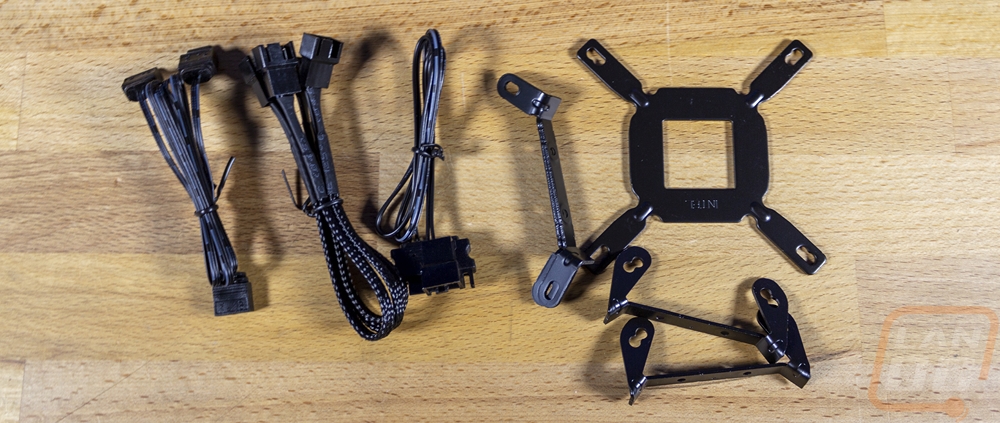
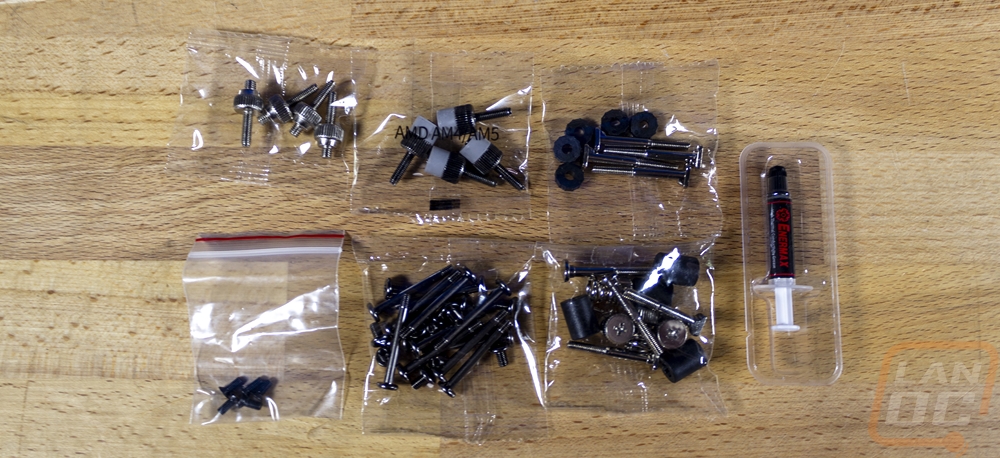
Sorry for having so many pictures but I wanted to be sure to show everything from both models but it does mean a lot of duplicates other than the color difference. For the fans the white Aquafusion Adv 240 came with two 120mm fans with the model number UCSQUARGBA12P-AQFA-W, the black model is the same only with B at the end and with AQFA in the model name it is clear that the model name here is specific to the Aquafusion Adv but these do look just like the Enermax SquA ADV aRGB 120MM PWM Fans so you can get matching fans for the rest of your case if needed. The fans run between 500 and 2000 RPM. They can push from 39 to 79.8 CFM and have from 0.67 to 3.6 mm H2O for pressure which is a lot of air and a lot of pressure. They run from 15 to 32.6 dBA according to Enermax as well. They have two color-matched cables, one is a four-pin PWM fan cable and the second is a 3-pin ARGB lighting cable which has a second lighting plug also attached so you can daisy chain the lighting together. They have a unique shape that has flat sides on two sides and tabs with a curved shape on two sides. Then on the back, the housing has 13 blade-like fins that hold the center of the fan in place. The specifications don’t list the bearing type but I did find that it is a hydraulic bearing. The mounting tabs do have thin color-matched rubber pads to help with vibration and on the front, the same flat-sided and rounded on the top and bottom is used on the diffused lighting ring. Both the black and white fans both have a white translucent fan blade as well that works with the lighting in the center housing to light up. Then in the center, they have the Enermax branding on the color-matched center sticker.
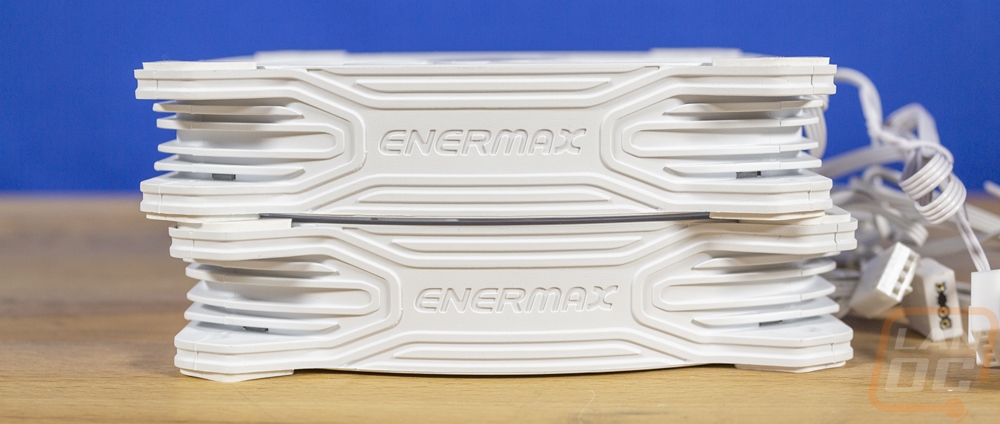




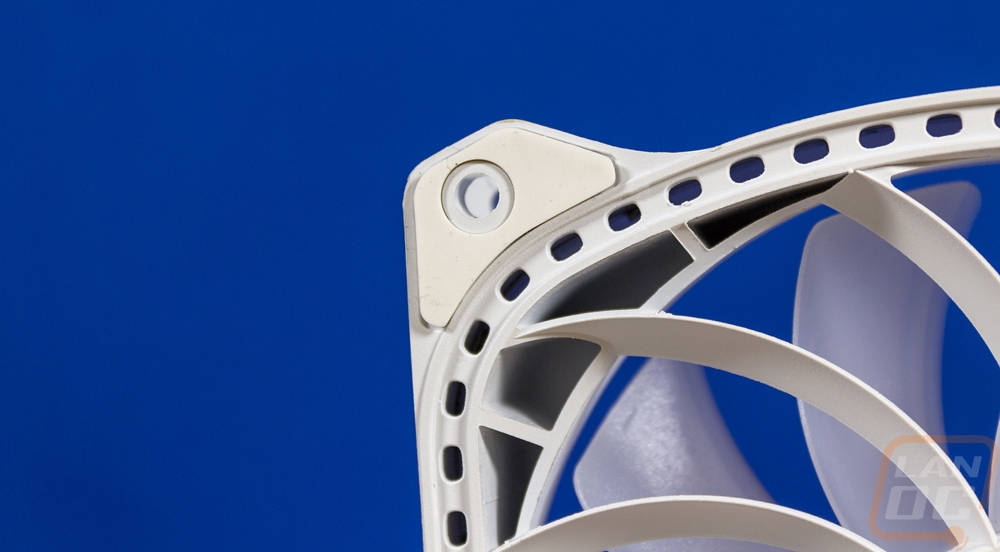

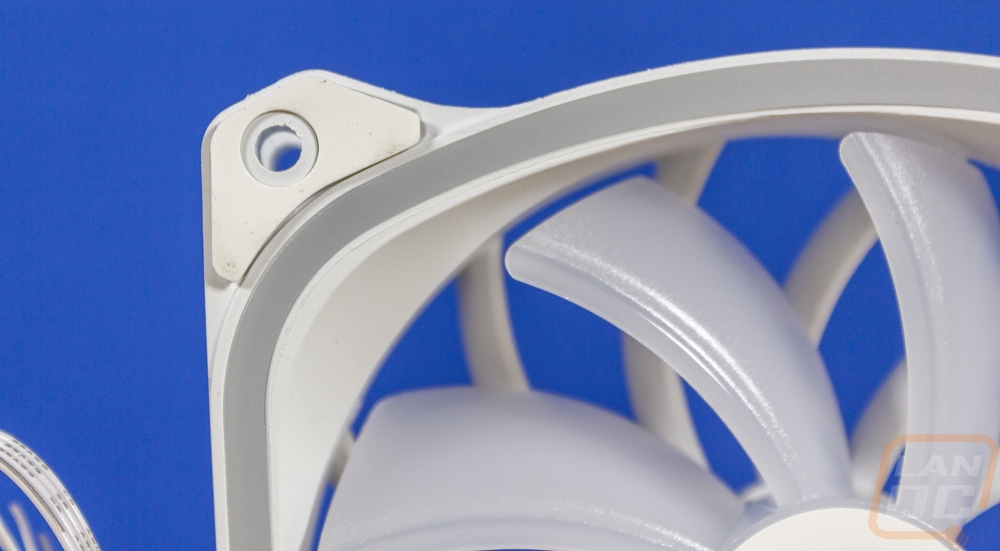
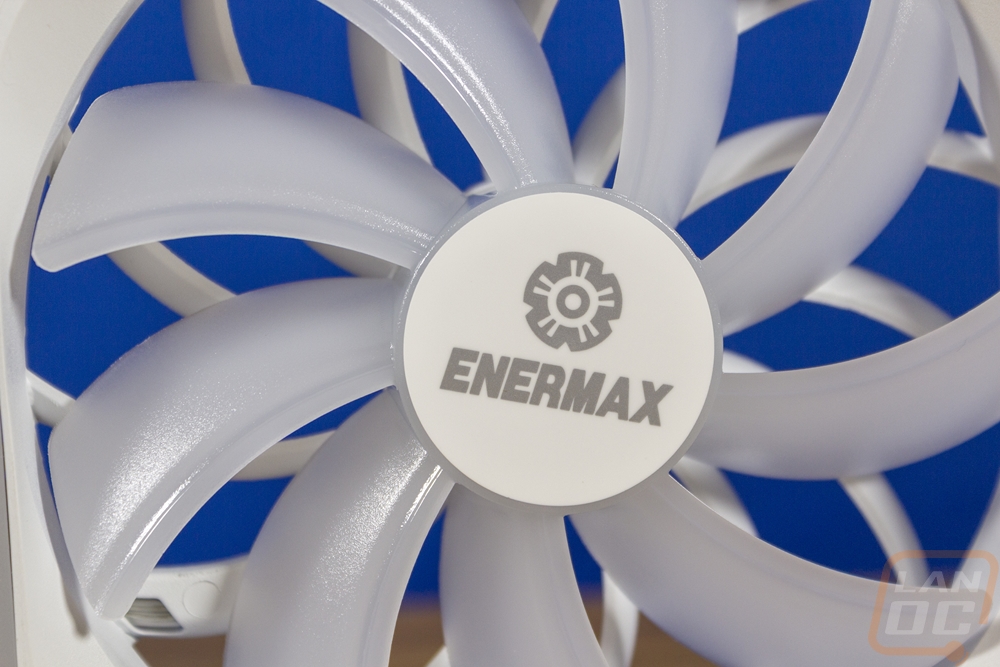
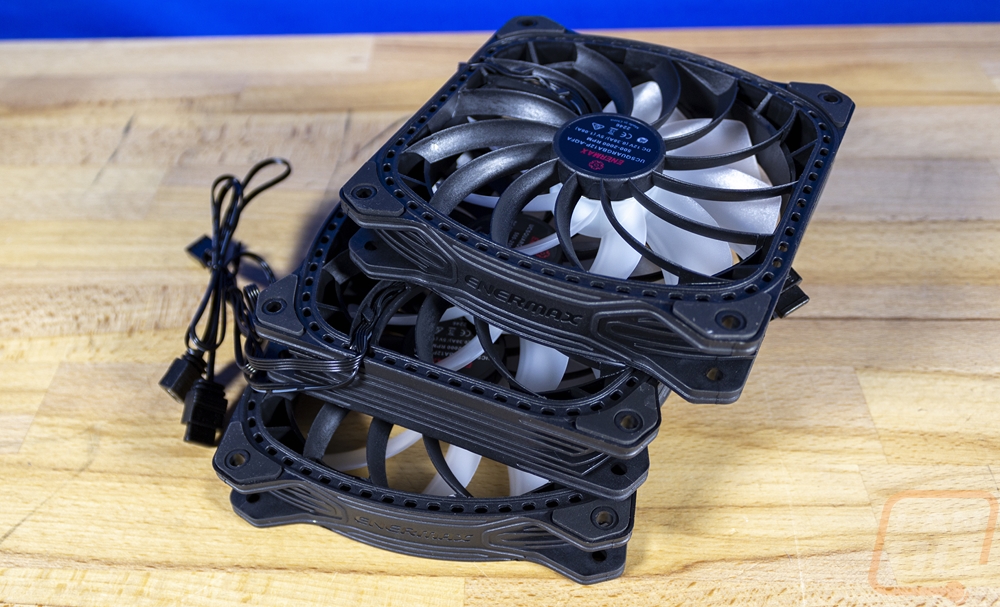

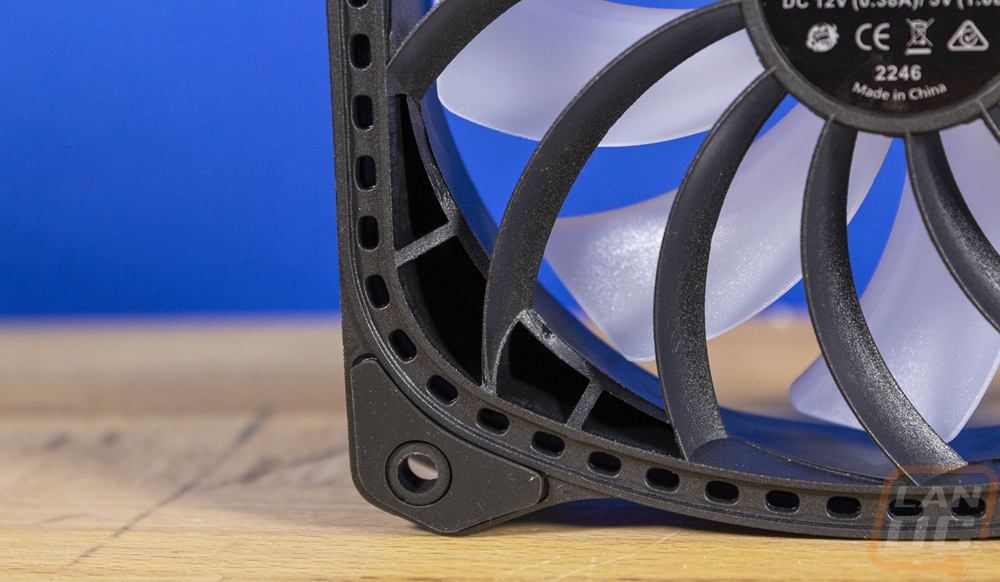
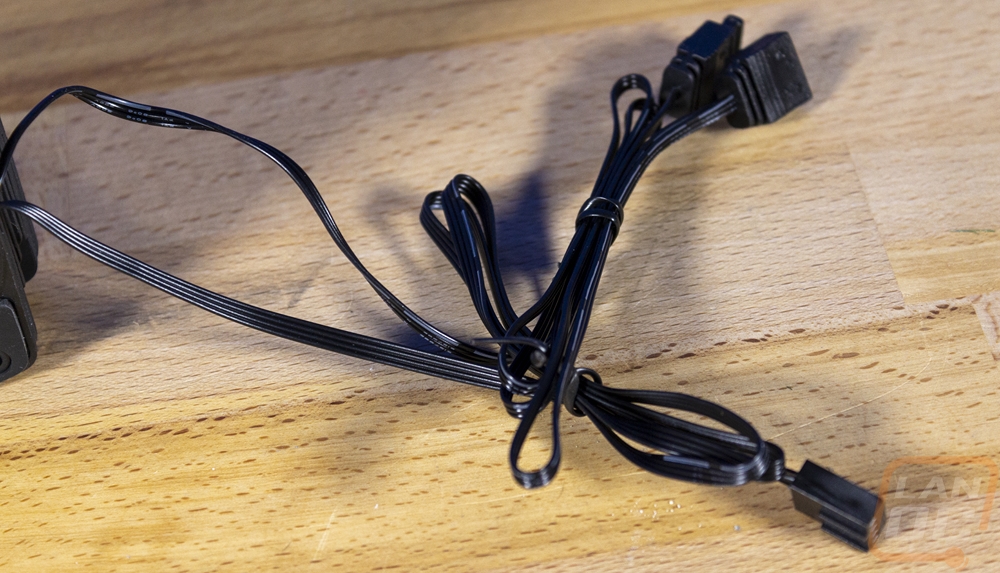
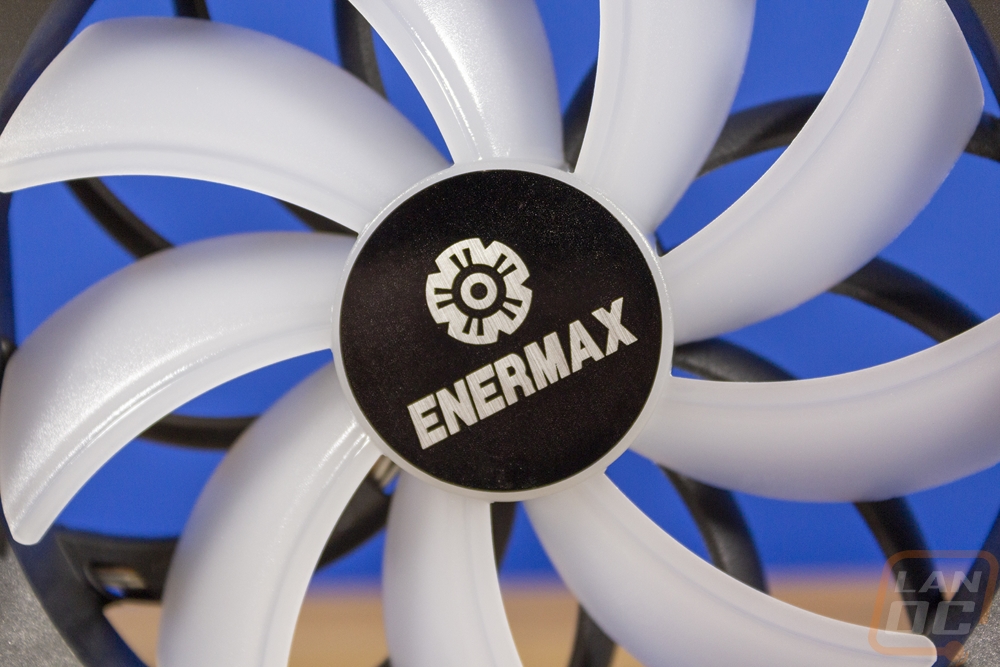
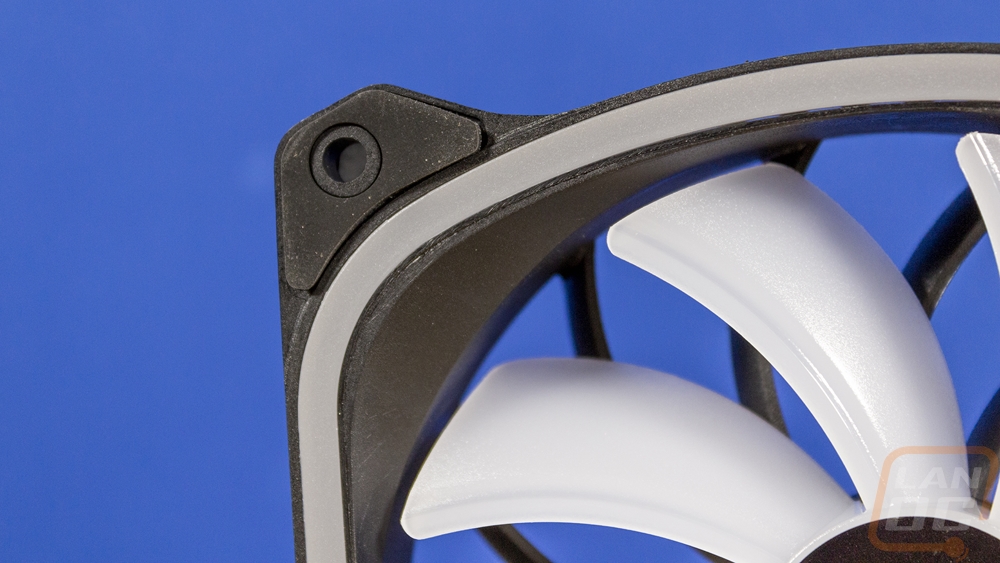

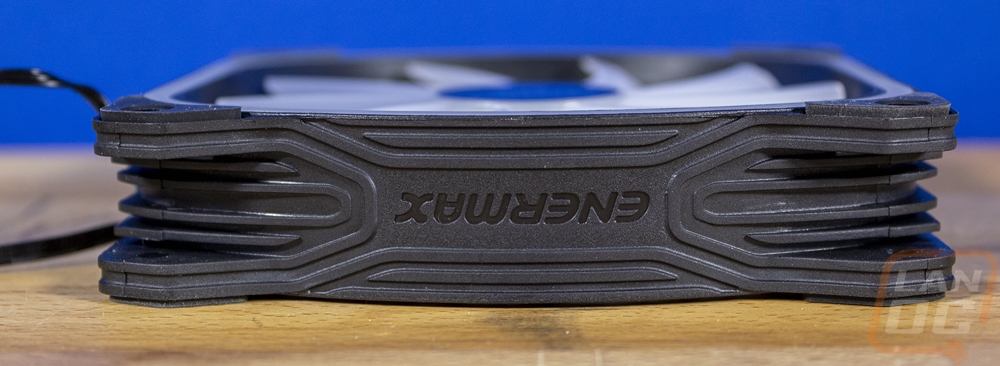
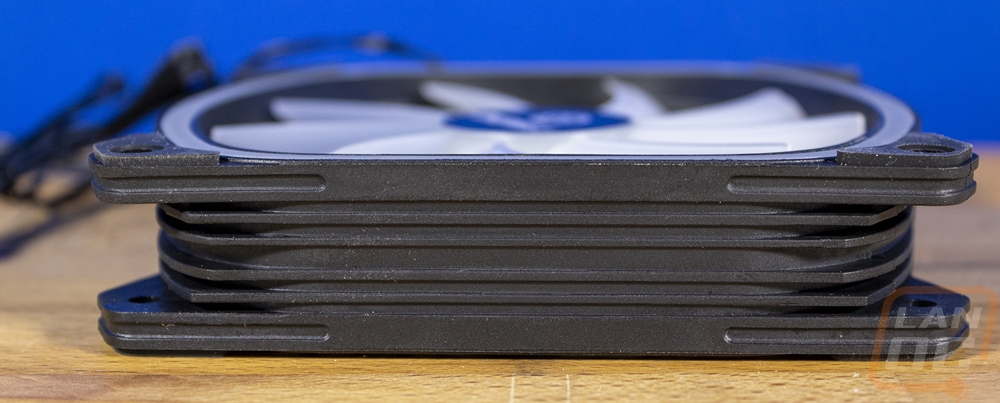
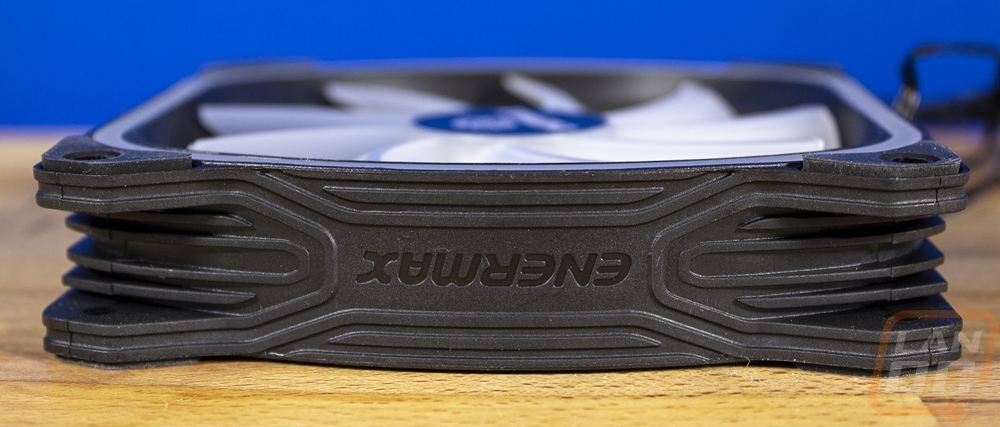

The radiator design for the Aquafusion Adv has the old school standard rounded ends and is a standard AIO size with a thickness of 27mm. Where it does stand out however is on the sides where they have stamped in a dogbone-like shape with the Enermax logo printed in the middle. The Enermax logo is hardly visible on the white model but is bright white on the black model. Also to note, like with the mounting hardware the screws they used to attach this side panel on the white model are black. But for the fins, they have finished those in white. It’s just interesting to see them go to extra lengths to color match things in white but then miss other parts. The radiator has an importer sticker on the end as well as a second sticker with the AIO serial number as well.




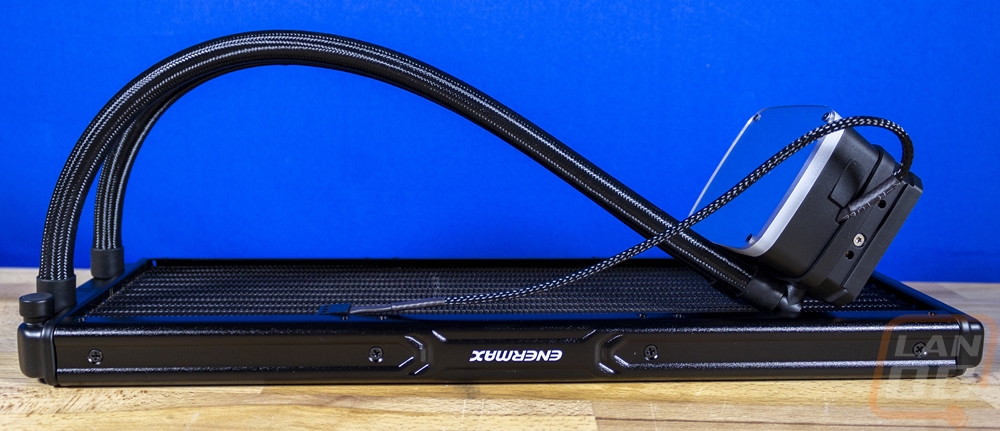
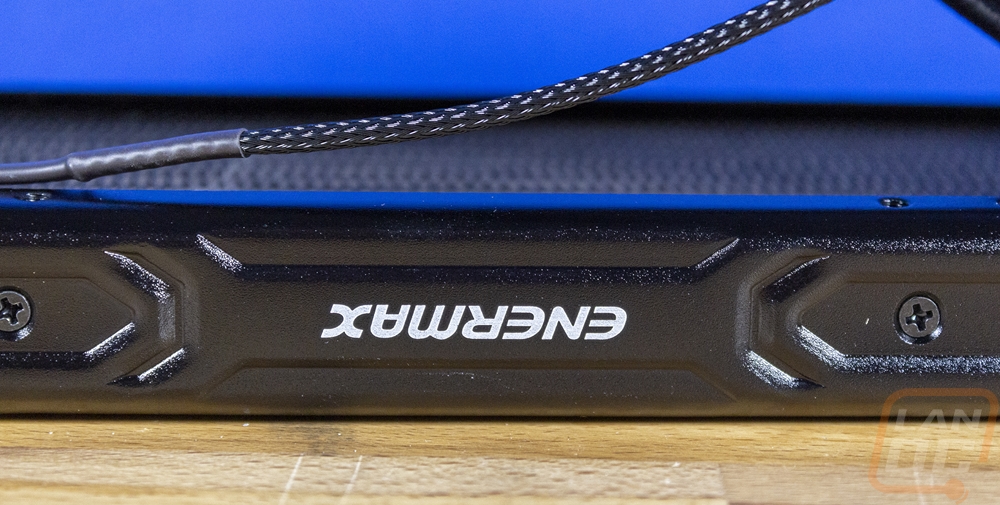
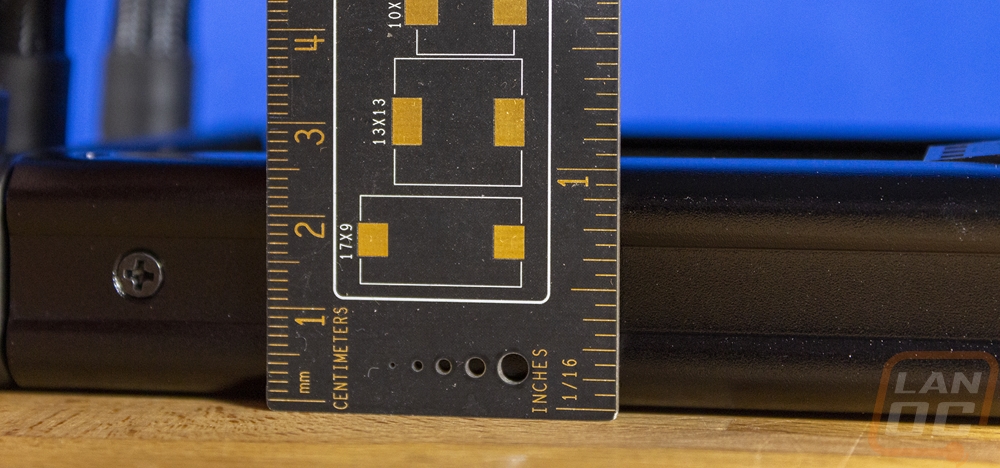
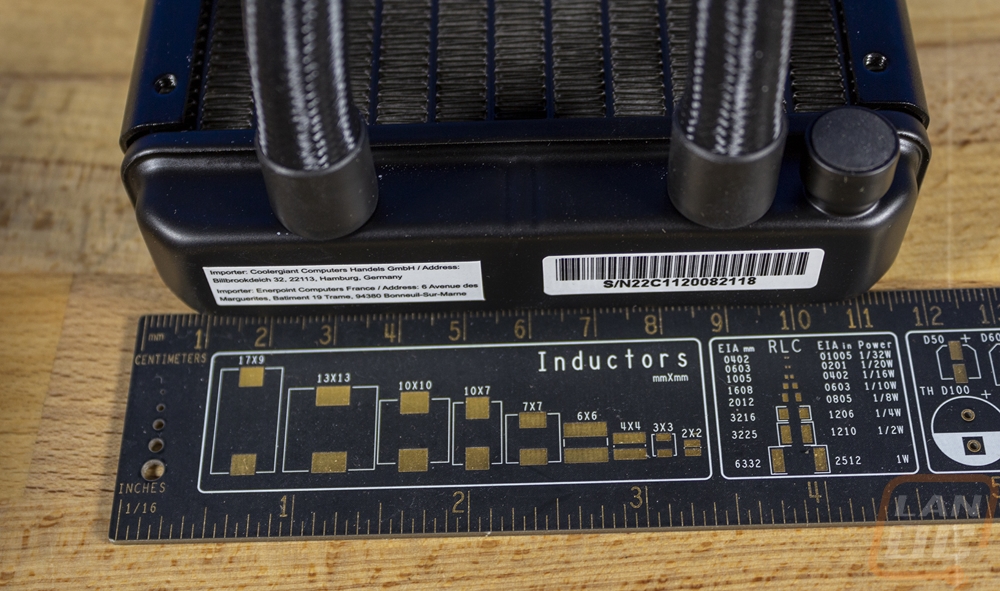
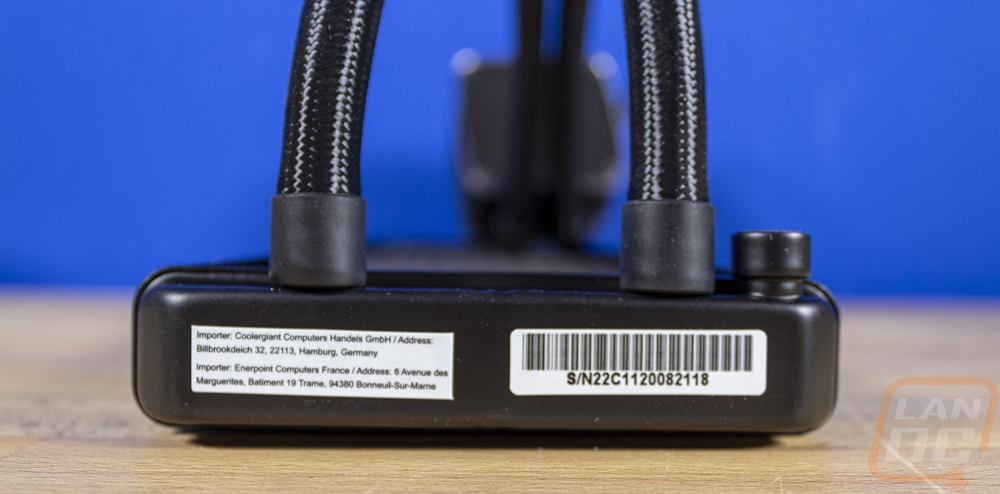
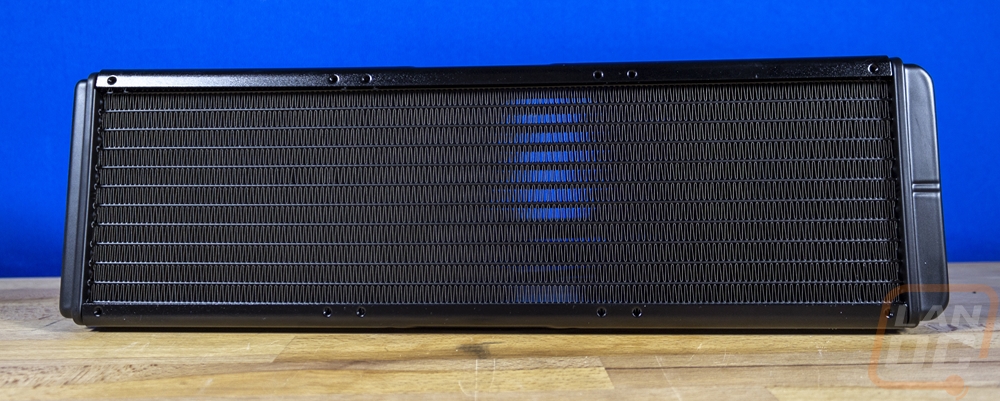
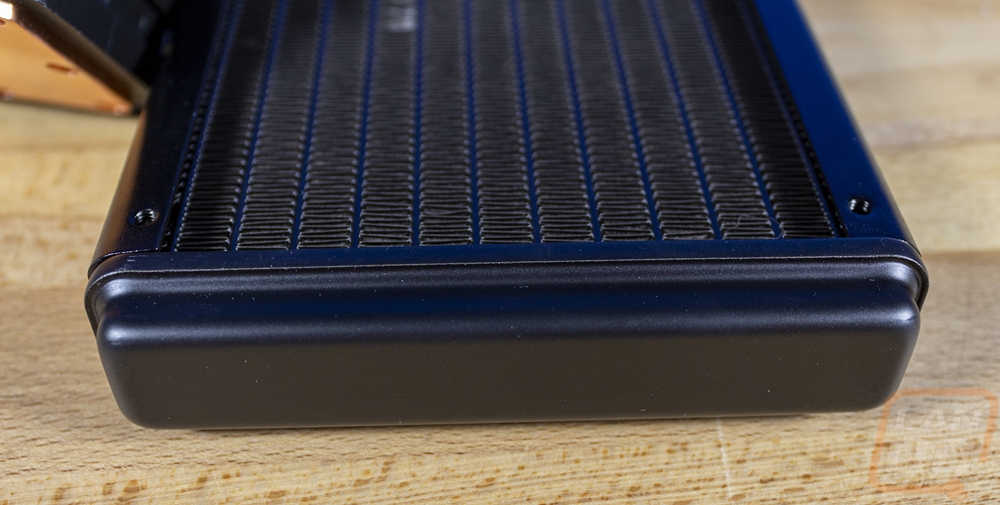
The hoses are 8mm wide and are sleeved. The black model has black sleeving and the white models have white sleeving though the white sleeving does have a slight hint of yellow. They did also change all of the plastic on the radiator to white to match including the fill cap.



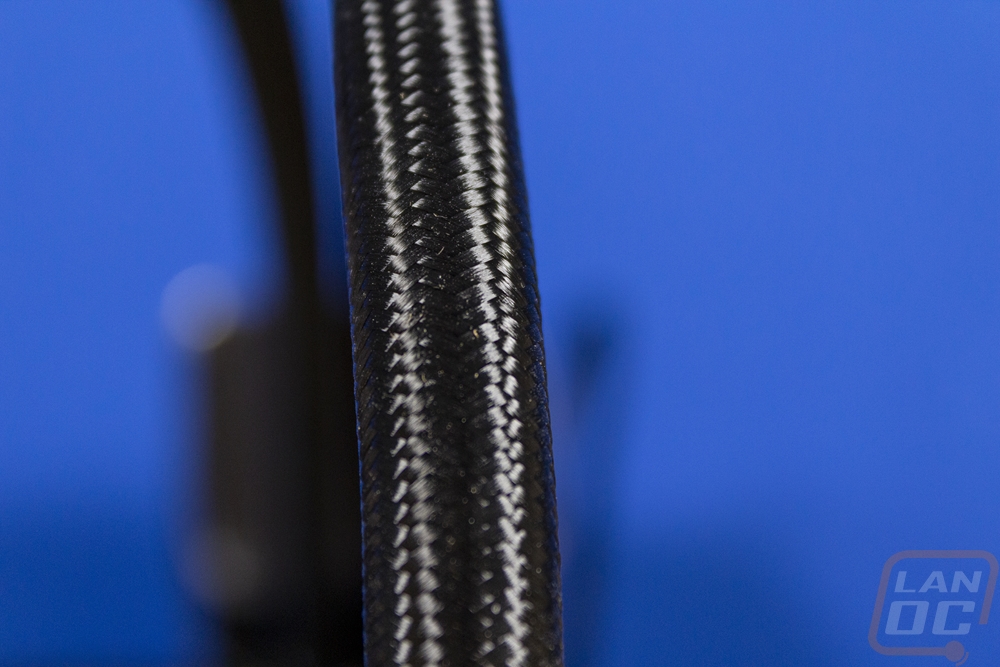

Then at the end of those hoses, we have the pump and water block all combined. The pump has a squared shape and is 54mm from the contact surface to the mirrored top. It has just one wire, a 3-pin fan header to let your PC know what fan speed everything is running to keep it from freaking out, and inside the pump uses a ceramic bearing to help with longevity. They use a dual chamber design and the pump pushes the coolant in at the center of the waterblock to get it on the hottest part of the CPU. Like with the other components the white model has bright white plastic for the pump housing and the white-sleeved hoses but the small right-angled connections here are black. At the bottom, it has a big copper contact surface which isn’t a perfect mirrored finish but does have a good reflection. The pump housing has a diffused ring around the outside of the top to put some RGB lighting in that direction. But it’s the top design that Enermax has put the most focus on. They call it "Infinite RGB Reflection” which they have a mirrored top that when lit up has an infinity mirror setup with lighting behind it. Right next to the fan wire, there is a color-matched rubber plug, behind this is where you hook up the included RGB cable. I’m surprised that cable didn’t come already attached like the fan cable which wouldn’t then leave as big of an opening.








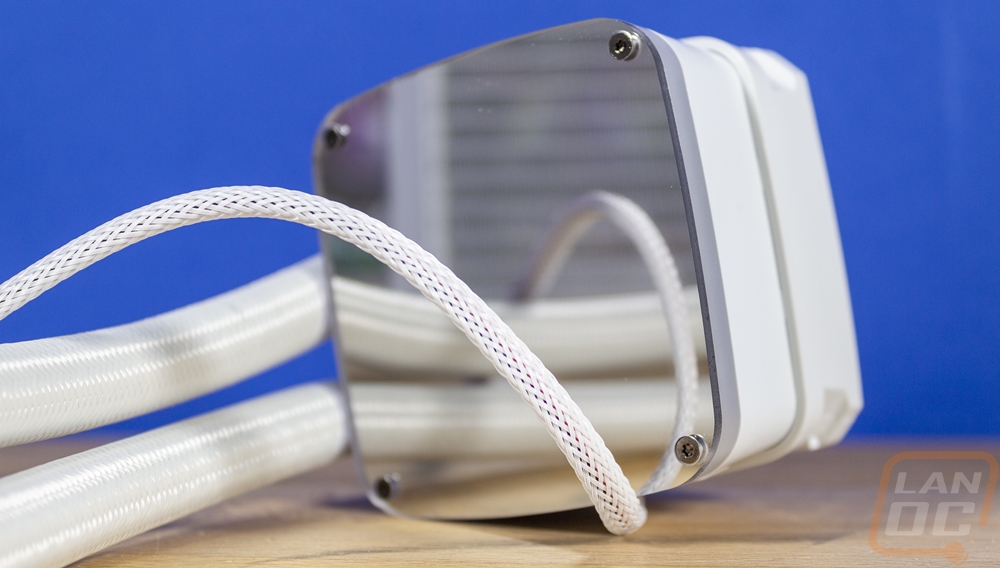
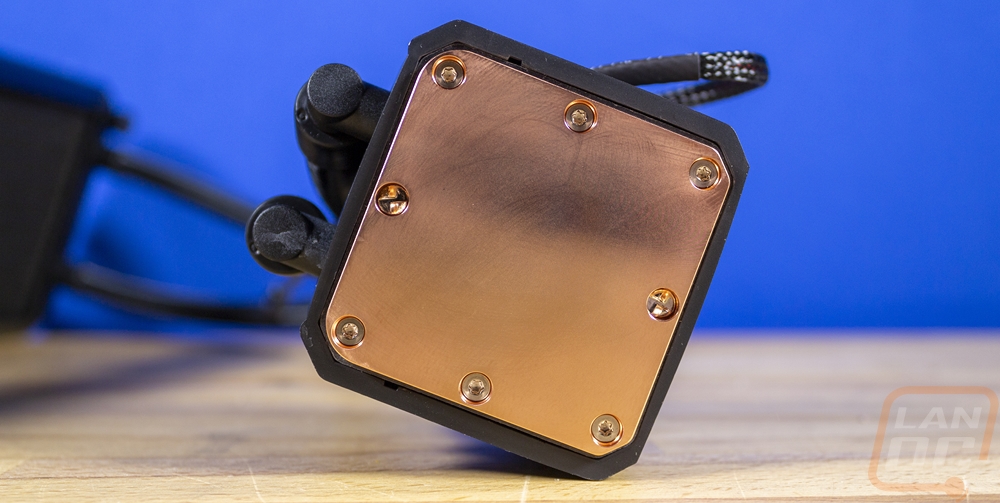
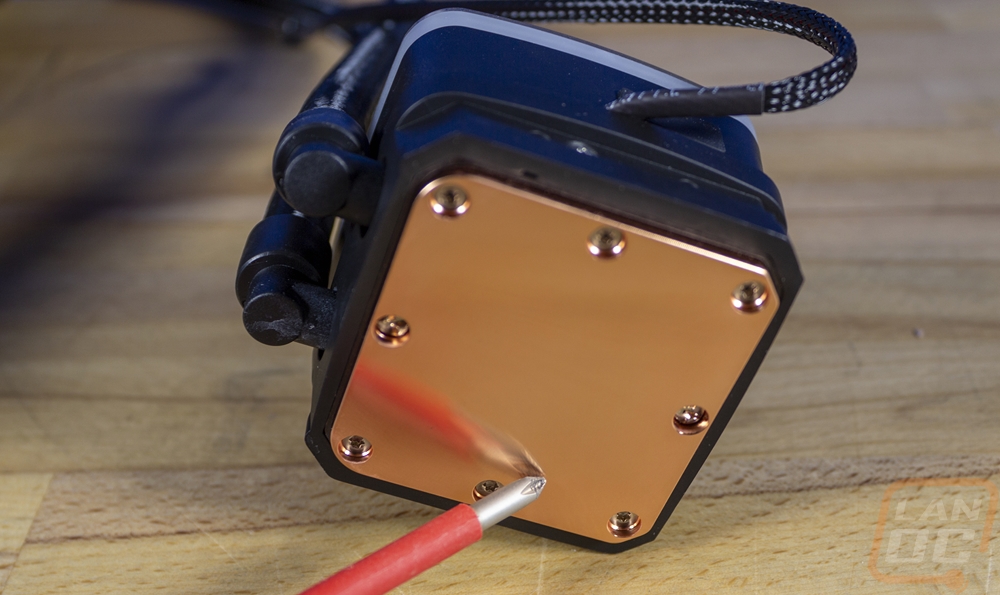
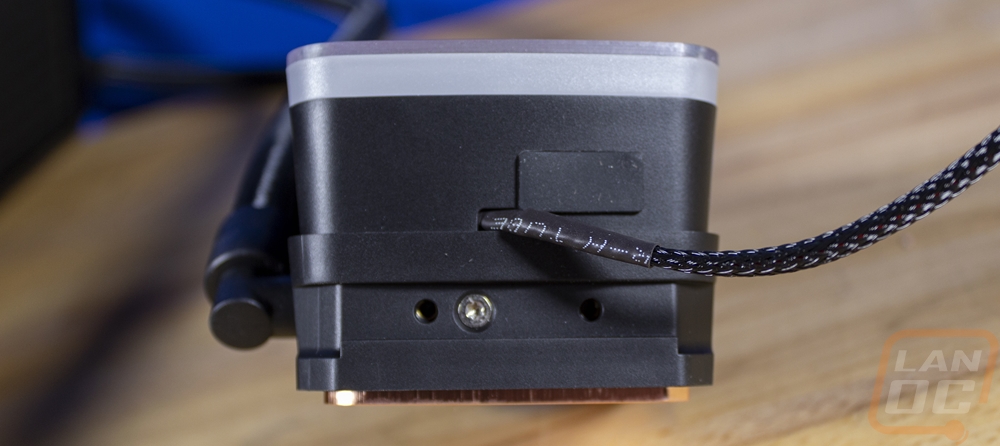
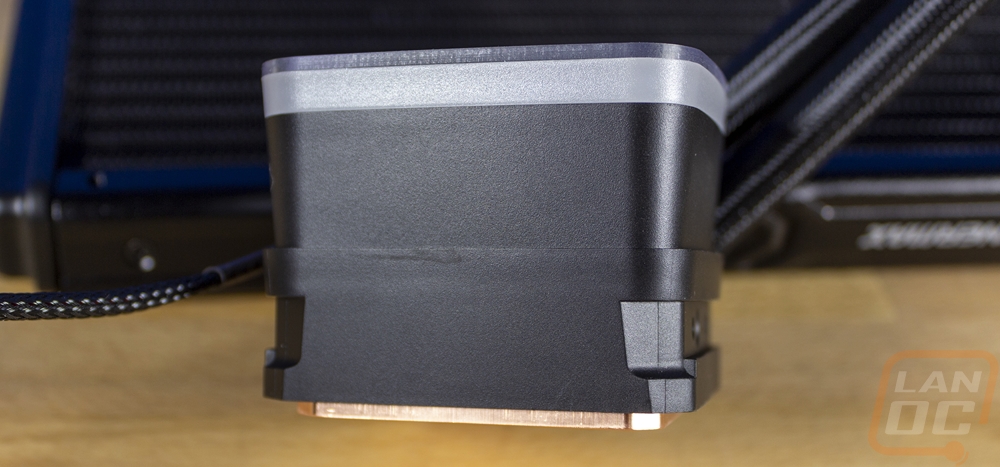
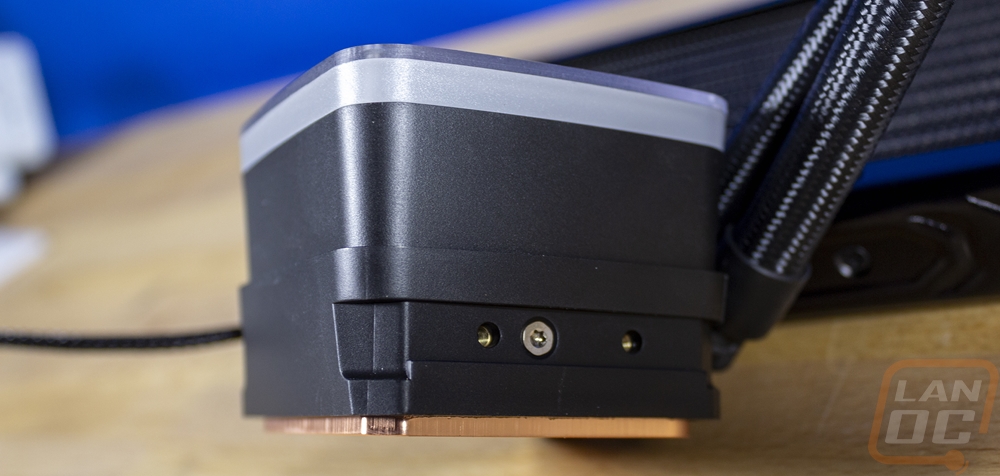
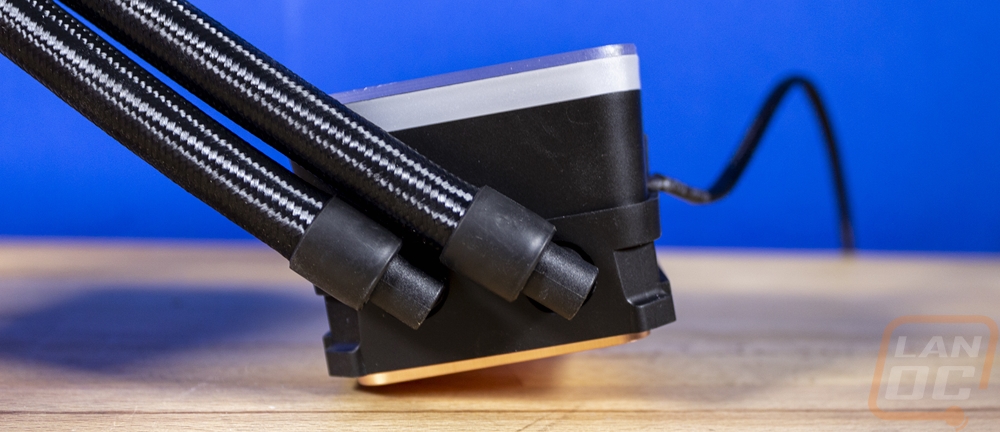
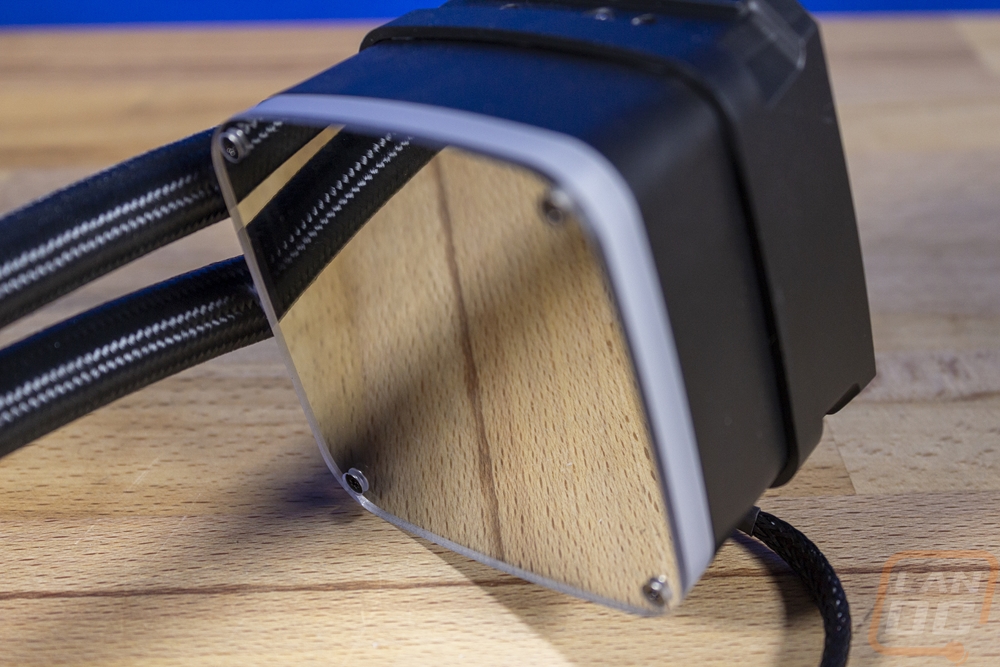
Test bench
|
Testing Hardware |
Live Pricing |
|
|
Case |
Primochill Wetbench |
|
|
Motherboard |
Asus ROG Maximus Z790 Extreme |
|
|
CPUs |
Intel i9-13900K PL1=PL2: 253, τ: 56 / 307A |
|
|
Ram |
Crucial 2x16GB 5600 MHz Kit |
|
|
Power Supply |
ToughPower GF3 1000W PSU |
|
|
Thermal Paste |
Noctua NT-H2 |
|
|
SSD |
Sabrent Rocket Q4 2TB |
|
|
OS |
Windows 11 Pro |
|
Noise Testing, Fitment, and Lighting
|
Cooler |
Height |
Width |
Depth |
Fits Tall Memory |
|
Enermax ETS-F40-FS ARGB |
140 mm |
158 mm |
93 mm |
Yes |
|
AIO Cooler |
Fan Configuration |
Radiator Thickness |
Water block height |
|
Corsair H100i Elite LCD Display |
2x 120mm |
27mm |
57mm |
|
Enermax Aquafusion Adv 240 White |
2x 120mm |
27mm |
54.5 mm |
|
Enermax Aquafusion Adv 360 Black |
3x 120mm |
27mm |
54.5 mm |
Before getting into noise testing, I did have to get everything installed and up and running. The ETS-F40-FS ARGB being an air cooler was less complicated than the rest. Its bracket design is very similar to what some of the Noctua coolers have. For our Intel LGA 1700 install you have your base back bracket and you have to get the correct standoffs, which you have two to pick from. Then with the standoffs, two different orientations help cover all of the socket sizes. We needed the silver standoffs and the bulge on the outside. Once those are installed you have plastic washers that fit snug that slide on them to hold them in place. You slide that up from the back and then on the top of your motherboard, you have plastic spacers you slide on. Then you attach the two wing-like brackets up on top with the spring-loaded nuts. There is one big downside to this, you do have to hold the bracket in place until you get things bolted together. Our test bench is running an Asus Z790 Extreme and the fitment was tight but I thought it worked. I found out in our testing that wasn’t the case. You could make this work with the first layer of fins bent, but you do want to make sure you have clearance if you are looking at the ETS-F40-FS ARGB, most motherboards don’t go as crazy with the VRM heatsinks and the M.2 cooler so it should be fine. But this is the first cooler I have run into issues with on this board. As far as memory clearance, the ETS-F40-FS ARGB is good unless you decide to mount it sideways which would put it up over most memory slots and we know that if it doesn’t clear the motherboard heatsinks here anything beyond bare PCB memory might be an issue.




If you were curious how close the fitment was, here is the contact that we had with the CPU. It's enough for some cooling and for a big AIO cooler or a low-end CPU that would be enough to get the job done but cooling a 13900K with ANY air cooler needs perfect contact.


The installation of the two Aquafusion Adv coolers was similar to the ETS-F40-FS on our LGA 1700 motherboard but they do have a differently shaped Intel backplate but it uses the same standoff design. The downside that the air cooler had where you have to hold the bracket from the back until you have everything attached is a bigger deal here because you aren’t just holding it until you get the top bracket installed like on the air cooler. This time around you have to get the pump in place and then the nuts go on. A design where the bracket is all locked into place and then you install the pump to that would be nicer and is how most AIO coolers do it. The Aquafusion Adv installation does require getting the fans installed on the radiator, which you can do ahead of time and they do include smaller screws as well to mount the radiator to your case. I noticed that the fans are especially susceptible to breaking on their mounting tabs. I use a powered screwdriver with a clutch to make sure I never over tighten screws and even on the lowest setting I had tabs bend and make cracking noises, even doing it by hand there was almost no room between being loose and being overtightened and breaking.

Beyond that, you have to install the mounting brackets to the pump and while it is a small detail I was surprised that the all-white model still has all-black brackets and hardware. Normally I would complain that a white kit ended up with chromed hardware, but with the mirrored pump top and white for every other small detail even the plastic around the white sleeving on the lines the black hardware seems out of place. White would be best, but a traditional chromed finish could go with it as well.


For noise testing, I have kept things simple. For each of the four devices tested, I tested at 50% fan speed, 100% fan speed, and then under load. For under load, this is with the AIDA64 CPU workload which is a little less demanding and more like an in-game workload. I did the noise testing 18-24 inches away from the radiator. For the Corsair, because it has its own software for load testing it was set to balanced and everything else is using the “standard” profile from the Asus motherboard. The ETS-F40 did well which is helped by having just one fan and that fan also only runs at up to 1200 RPM. The two Aquafusion Adv coolers both have fans that are faster, running up to 2000 RPM at 100% fan speed and that shows in those tests where they were louder than the H100i. While under load however the Aquafusion Adv both were quieter than the H100i which is the only result that really matters unless you plan on cranking your fans up for the fun of it.
|
Noise Testing |
50% Fan Speed |
100% Fan Speed |
Under Load |
|
Corsair H100i Elite LCD Display |
35.9 |
46 |
45.9 |
|
Enermax ETS-F40-FS ARGB |
32.1 |
37.2 |
37.2 |
|
Enermax Aquafusion Adv 240 White |
38.6 |
50.5 |
42.1 |
|
Enermax Aquafusion Adv 360 Black |
39.8 |
52.4 |
45.1 |
|
Enermax Aquafusion Adv 360 Black Retest |
39.8 |
52.4 |
41.8 |
For lighting, the ETS-F40-FS ARGB which has dual lightbars across the top of the cooler and the single fan isn’t anywhere close to the same as what they have going on with both of the Aquafusion Adv coolers. But for an air cooler I do like that Enermax tied in the heatsink itself, not just the fan like most RGB air coolers have. Of course, if you don’t want lighting, they do have the original models without it.




As for the Aquafusion Adv coolers their RGB lighting is split into two sections. You have the lighting on the pump and then the fans. We are fortunate to be able to check out what the lighting looks like on both the black and white models. For the pump, they have a mirrored infinity effect which gives you six thin rings around the outside on the inside of the infinity effect as well as the Enermax logo in the middle looking like it is floating. The outer rings get smaller for each layer which gives the infinity effect a unique look. The pump does also have one big ring around the outside as well.





As much as I like the infinity design of the pump on the Aquafusion Adv, I like the fan design even more. The fan blades are made in a translucent white for both the white and black models which is then lit up from the center to give the blades a nice blended effect. But the ring around the front of the fan is the main event, with that ring being brighter and it has a much higher LED count which allows it to get the full spectrum around the ring all at once. This does also highlight the unique shape fans which are flat on the sides, with rounded corners but also rounded on the top and bottom. With it being lit up, it looks a lot closer to the Cooler Master logo shape than I’m sure Enermax would want to admit lol. All together the Aquafusion Adv lighting is unique and looks great. I’m surprised the design doesn’t have its own lighting controller to get all of the unique effects, but in the end, I prefer having everything tied in together with my motherboard and other components which is what Enermax is doing here. It helps keep costs down as well, which is a nice bonus.






Cooling Performance
For testing on the Enermax ETS-F40-FS ARGB and both the Enermax Aquafusion Adv 240 White and the Aquafusion Adv 360 Black, I set them up on our 13900 K-based test bench and ran a few different tests. I tested using the AIDA64 Stress Test with the always demanding FPU workload, I should also point out that all temps listed are from the CPU sensor, not the CPU package. I did these with the stock fan profile as well as with the fans and pump for the AIOs at 100%. I also tested our test benches Corsair H100i Elite for a point of comparison as well. With the stock fan profile, the ETS-F40 which we already know had contact issues because of the height of our VRM heatsinks reached 89c and throttled back. The Aquafusion Adv 240 did well at 64c, 4c lower than the H100i, and the Aquafusion Adv 360 which should have done even better was warmer at 70c. I reinstalled the Aquafusion Adv 360 multiple times and retested more times than I could count, but it just didn’t do as well even with the longer radiator and additional fan. Cranking the fans up to 100% the ETS-F40 and the Aquafusion Adv 360 which struggled didn’t show any improvement but the Aquafusion Adv 240 and the H100i did drop down but just by one degree.
*update* I did update the numbers below with the replacement Aquafusion Adv 360 that Enermax sent over and you can see that it did fix the issue that we saw in our testing. With the FPU workload, the stock fan profile dropped down to 62c from 70c and with the fans cranked up it ran a little cooler at 60c. Both were the coolest results of the coolers tested.
|
AIDA64 FPU Stress Test |
Stock Fan Profile |
100% Fan Speed |
|
Corsair H100i Elite LCD Display |
68c |
67c |
|
Enermax ETS-F40-FS ARGB |
89c |
89c |
|
Enermax Aquafusion Adv 240 White |
64c |
63c |
|
Enermax Aquafusion Adv 360 Black |
70c |
70c |
|
Enermax Aquafusion Adv 360 Black Retest |
62c |
60c |
I did the same test as above only using AIDA64’s FPU workload but this time I uncapped the PL2 settings on the Intel i9-13900K. For this test, there was no point in looking at the temperatures, for each cooler it would max out the temperatures. I just kept an eye on the total wattage that the CPU used in HWMonitor to see how each did. The ETS-F40 with its contact issues did the worst of course. That said even with the less than perfect contact the F40 is rated at a 200-watt TDP and it came in at 208, so it wasn’t too far off. The H100i did 271 watts and we can see the Aquafusion Adv 360 was a little below that at 262. But the Aquafusion Adv 240 did well reaching 297 watts.
*Update* The performance numbers have been updated with the replacement Aquafusion Adv 360 and the replacement was able to improve on the performance of the original by 62 watts. This put it up at the top of the coolers tested, no surprises there given it is later than the other coolers. The performance between the 240 and 360 here wasn't much but that is more because of the 240 over performing than anything else.
|
AIDA64 FPU Stress Test With PL2 uncapped and 100% Fan Speed |
CPU Wattage |
|
Corsair H100i Elite LCD Display |
271 |
|
Enermax ETS-F40-FS ARGB |
208 |
|
Enermax Aquafusion Adv 240 White |
297 |
|
Enermax Aquafusion Adv 360 Black |
262 |
|
Enermax Aquafusion Adv 360 Black Retest |
301 |
For my last test, I continue using AIDA64’s Stress Test but switch over to the CPU workload from FPU. In my experience, the CPU workload is similar to what you will see for everyday use in games and other regular PC use whereas the FPU workload is similar to what your CPU will do when rendering. With the CPU workload, all of the coolers run cooler. The H100i was running at 63c and down to 61c at 100% fan speed. The ETS-F40 still struggled and was at 88c for both tests still. The Aquafusion Adv 240 ran at 60c and with the fans cranked up to 100% it dropped 3 degrees to 57c. The Aquafusion Adv 360 was still behind the 240 and the H100i at 65c and while it did drop, it didn’t drop as much at 100% fan speed as the others with it dropping just 1c to 64c.
*Update* We did get in a replacement for the Aquafusion Adv 360 and retested and you can see that it performed better than our initial testing. With the stock fan profile, it ran at 55c, 10c less than our original did, and 5c lower than the Aquafusion Adv 240.
|
AIDA64 CPU Stress Test |
Stock Fan Profile |
100% Fan Speed |
|
Corsair H100i Elite LCD Display |
63c |
61c |
|
Enermax ETS-F40-FS ARGB |
88c |
88c |
|
Enermax Aquafusion Adv 240 White |
60c |
57c |
|
Enermax Aquafusion Adv 360 Black |
65c |
64c |
|
Enermax Aquafusion Adv 360 Black Retest |
55c |
51c |
Overall and Final Verdict
With both the Aquafusion Adv coolers and the ETS-F40-FS ARGB it is obvious that Enermax is killing it when it comes to aesthetics and RGB lighting. The F40 cooler looks amazing in its all blacked out design but they also sell an all-white model that looks even better. The F40 also integrates RGB lighting up into the top of the cooler as well as the fan whereas most air coolers that have lighting just have it in the fan. The Aquafusion Adv coolers are similar as well. They are available in both black and white which means you can find one that is going to match your build and with the Aquafusion Adv being available in 120, 240, and 360 models you will most likely find one that fits what you need size-wise as well though they are sadly missing 140 mm fan based sizes. The Aquafusion Adv stands out once you get into its lighting with the included fans having individually addressable lighting in the diffused squared-off ring around the outside as well as in the blade itself. But it’s the lighting on the pump that I like the most. The pump has a ring around the outside and then the infinity design on top.
They both have their downsides as well. The F40 cooler for example didn’t fit our test bench with the taller VRM heatsinks on the Z790 Extreme causing it to get less than ideal contact. The F40 is also a little less than is needed to handle the 13900K on our test bench even in ideal testing conditions. For the Aquafusion Adv, I ran into a few smaller issues like the pump mounting design being a little more difficult than it needs to be because the bracket doesn’t get held in place until you attach the pump. I also wasn’t a big fan of the mounting hardware on the all-white model being black, they worked so hard to get everything white to then just reuse the black hardware when chrome could have worked. I also had issues with the mounting tabs on the Aquafusion Adv fans being thin and easy to crack or break. But the biggest issue was of course the inconsistent performance between the two kits. The Aquafusion Adv 240 performed amazingly well but then the larger Aquafusion Adv 360 ran warmer than it in all of our tests even after redoing the mounting, checking the contact surface multiple times, and more. The Aquafusion Adv 240 shows just how capable the Aquafusion Adv is and I bet if the 360 model were performing as well as it should have it would have been even better. But it does show that there is the possibility that you can see less than ideal performance with some kits. Frankly, I would prefer it completely fail so at least it is obvious you have a problem. The 2000 RPM fans on the Aquafusion Adv are also a double edge sword, they offer the possibility of good cooling but are relatively loud when cranked up.
Overall both the RTS-F40 and the Aquafusion Adv have great aesthetics and have the potential to be solid performers in their respective cooling classes. But once we get into the details they also had big downsides as well. For pricing the F40 air cooler has an MSRP of $49.99, it was previously on sale for $39.99 so keep an eye out for that. Then for the Aquafusion Adv, the 360 model is $119, the Aquafusion Adv 240 is $99.99, and the Aquafusion Adv 120 is $79.99. That pricing makes the Aquafusion Adv a good value once you figure in the lighting that the fans have. Most kits anywhere near that price range have more basic blade-only lighting and often no lighting on the pump or a backlit logo whereas the Aquafusion Adv has the infinity design and the outer ring of lighting as well. The pricing does mean that the Aquafusion Adv would be on my shortlist for a budget build if I wanted to have some lighting, but I would be sure to make sure the performance I’m getting is what the cooler is capable of.
*Update* Enermax did send a replacement for the Aquafusion Adv 360 that we had issues with and I have updated all of our performance testing to include the retested results of that cooler. The replacement cooler did fix the performance issue and the new cooler ended up being the best performing cooler out of the coolers tested. I have left the original conclusions and performance numbers as well. As expected the Aquafusion Adv 360 is a great performing cooler. But my original concern with inconsistent performance is still a possibility so it is still important to note. This is especially true in this situation where the cooler didn't stop working which is an issue that would be noticeable right away.
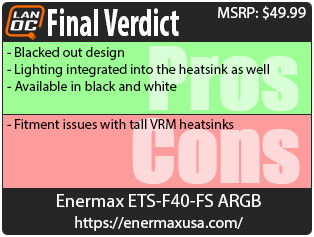
Live Pricing: HERE

Live Pricing: HERE




